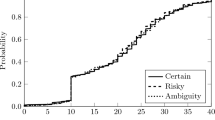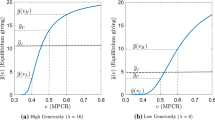Abstract
This uncertain dictator experiment found support for partial crowding out. Ninety-seven percent of private contributions were crowded out when tax rates were increased from 0 to 10 percent of income. Subjects who were uncertain whether they would be the donor or charity recipient pledged larger contributions and had lower levels of crowding out. Crowding out appeared asymmetric in that decreases in government contributions did not stimulate equivalent increases in private contributions. In the case of certainty, donors actually decreased contributions when government contributions decreased. The donor's gender did not influence contributory behavior.
Similar content being viewed by others
References
Abrams, Burton A.; Schmitz, Mark D. “The ‘Crowding-Out’ Effect of Governmental Transfers on Private Charitable Contributions,”Public Choice, 33, 1978, pp. 30–9.
—— “The Crowding Out Effect of Governmental Transfers on Private Charitable Contributions: Cross-Section Evidence,”National Tax Journal, 37, 1984, pp. 563–68.
Amos, Orley M. “Empirical Analysis of Motives Underlying Individual Contributions to Charity,”Atlantic Economic Journal, 10, 1982, pp. 45–52.
Andreoni, James. “Giving with Impure Altruism: Applications to Charity and Ricardian Equivalence,”Journal of Political Economy, 97, 1989, pp. 1447–58.
——. “Impure Altruism and Donations to Public Goods: A Theory of Warm-Glow Giving,”The Economic Journal, 100, 1990, pp. 464–77.
——. “An Experimental Test of the Public-Goods Crowding-Out Hypothesis,”The American Economic Review, 83, 1993, pp. 1317–27.
Andreoni, James; Vesterlund, L. “Which is the Fair Sex? Gender Differences in Altruism,”The Quarterly Journal of Economics, February, 2001, pp. 293–312.
Becker, Gary S. “A Theory of Social Interactions,”Journal of Political Economy, 82, 1974, pp. 1063–93.
Bergstrom, Theodore C.; Blume, Lawrence; Varian, Hal. “On the Private Provision of Public Goods,”Journal of Public Economy, 29, 1986, pp. 25–50.
Bernheim, B. Douglas. “On the Voluntary and Involuntary Provision of Public Goods,”American Economic Review, 76, 1986, pp. 789–93.
Bolton, Gary E.; Katok, Elena. “An Experimental Test of the Crowding Out Hypothesis: The Nature of Beneficent Behavior,”Journal of Economic Behavior and Organization, 37, 1998, pp. 315–31.
Bolton, Gary E.; Ockenfels, A. “ERC: A Theory of Equity, Reciprocity, and Competition,”American Economic Review, 90, 2000, pp. 166–93.
Brooks, Arthur. “Is There a Dark Side to Government Support for Nonprofits?”Public Administration Review, 60, 2000, pp. 211–19.
Brown-Kruse, Jamie; Hummels, David. “Gender Effects in Laboratory Public Goods Contribution,”Journal of Economic Behavior and Organization, 22, 1993, pp. 255–67.
Callen, Jeffrey. “Money Donations, Volunteering, and Organizational Efficiency,”The Journal of Productivity Analysis, 5, 1994, pp. 215–28.
Cason, Timothy N.; Mui, Vai-Lam. “A Laboratory Study of Group Polarization in the Team Dictator Game,”The Economic Journal, 107, 1997, pp. 1465–83.
Clotfelter, Charles T.Federal Tax Policy and Charitable Giving, NBER Publication, Chicago, IL: University of Chicago Press, 1985.
Dawes, R.; McTavish, J.; Shaklee, H. “Behavior, Communication, and Assumptions About Other People's Behavior in a Commons Dilemma Situation,”Journal of Personality and Social Psychology, 35, 1977, pp. 1–11.
Day, Kathleen M.; Devlin, Rose Anne. “Volunteerism and Crowding Out: Canadian Econometric Evidence,”Canadian Journal of Economics, 29, 1996, pp. 37–53.
Eagly, Alice H. “The Science and Politics of Comparing Women and Men,”American Psychologist, 50, 1995, pp. 145–58.
Eckel, C. C.; Grossman, P. “Are Women Less Selfish Than Men? Evidence from Dictator Experiments,”Economic Journal, 57, 1997, pp. 726–35.
Hughes, P. N.; Luksetich, W. “The Relationship Among Funding Sources for Art and History Museums,” presented at the 26th annual conference of the Association for Research on Nonprofit Organizations and Voluntary Action (ARNOVA), Indianapolis, IN, 1997, as cited in Brooks, 2000.
Isaac, R. M.; McCue, K.; Plott, C. “Public Goods Provision in an Experimental Environment,”Journal of Public Economics, 26, 1985, pp. 51–74.
Jones, Philip R. “Aid to Charities,”International Journal of Social Economics, 10, 1983, pp. 3–11.
Khanna, J.; Posnett, J.; Sandler, T. “Charity Donations in U.K.: New Evidence Based on Panel Data,”Journal of Public Economics, 56, 1995, pp. 257–72.
Kingma, Bruce R. “An Accurate Measure of the Crowd-Out Effect, Income Effect, and Price Effect for Charitable Contributions,”Journal of Political Economy, 97, 1989, pp. 1197–207.
Ledyard, John O. “Public Goods: A Survey of Experimental Research,” in John H. Kagel and Alvin E. Roth, eds.,Handbook of Experimental Economics, Princeton, NJ: Princeton University Press, 1995, pp. 111–94.
Lindsey, L.; Steinberg, R. “Joint Crowdout: An Empirical Study of the Impact of Federal Grants on State Government Expenditures and Charitable Donations,”National Bureau of Economic Research, Working Paper No. 3226, 1990.
Margolis, Howard.Selfishness, Altruism, and Rationality, Cambridge, MA: Cambridge University Press, 1982.
Mason, C. F.; Phillips, O. R; Redington, D. B. “The Role of Gender in a Non-Cooperative Game,”Journal of Economic Behavior and Organization, 15, 1991, pp. 215–35.
Nowell, C.; Tinkler, S. “The Influence of Gender in the Provision of a Public Good,”Journal of Economic Behavior and Organization, 25, 1994, pp. 25–36.
Pindyck, Robert S.; Rubinfeld, Daniel L.Econometric Models and Economic Forecasts. New York, NY: McGraw-Hill, Inc., 1991.
Reece, William S. “Charitable Contributions: New Evidence on Household Behavior,”American Economic Review, 69, 1979, pp. 142–51.
Reece, William S.; Zieschang, Kimberly D. “Consistent Estimation of the Impact of Tax Deductibility on the Level of Charitable Contributions,”Econmetrica, 53, 1985, pp. 271–93.
Roberts, R. D. “A Positive Model of Private Charity and Public Transfers,”Journal of Political Economy, 92, 1984, pp. 136–48.
Rose-Ackerman, Susan. “Do Government Grants to Charity Reduce Private Donations?” in Michelle White, ed.,Nonprofit Firms in a Three Sector Economy, Washington, DC: Urban Institute, 1981.
Schiff, Jerald. “Does Government Spending Crowd Out Charitable Contributions?”National Tax Journal, 38, 1985, pp. 535–46.
——.Charitable Giving and Government Policy: An Economic Analysis, Westport, CT: Greenwood Press, 1990.
Stark, Oded. “On Private Charity and Altruism,”Public Choice, 46, 1985, pp. 325–32.
Steinberg, Richard. “Empirical Relations Between Government Spending and Charitable Donations,”Journal of Voluntary Action Research, 14, 1985, pp. 54–64.
——. “Voluntary Donations and Public Expenditures in a Federalist System,”American Economic Review, 77, 1987, pp. 24–36.
Sugden, Robert. “On the Economics of Philanthropy,”The Economic Journal, 92, 1982, pp. 341–50.
Warr, Peter G. “Pareto Optimal Redistribution and Private Charity,”Journal of Public Economics, 19, 1982, pp. 131–38.
Author information
Authors and Affiliations
Additional information
Funding for this experiment was provided by the Dean of the School of Business and Public Affairs.
Rights and permissions
About this article
Cite this article
Benzing, C., Andrews, T. The effect of tax rates and uncertainty on contributory crowding out. Atlantic Economic Journal 32, 201–215 (2004). https://doi.org/10.1007/BF02299438
Issue Date:
DOI: https://doi.org/10.1007/BF02299438




